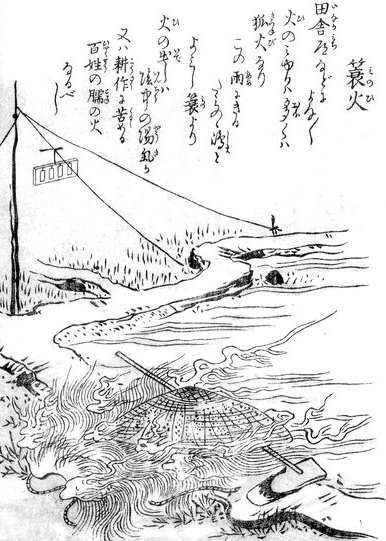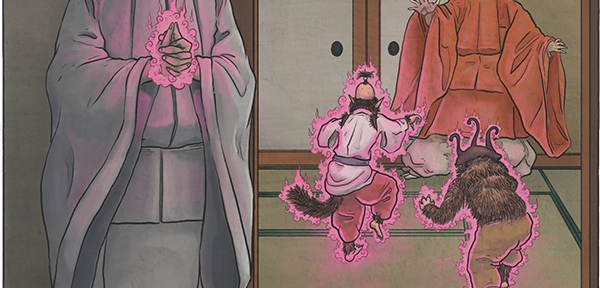Hello everyone! Today a few new stretch goals were added to the Kickstarter: a few more options for yokai-themed bookmarks to go with my previous yokai books, as well as yokai t-shirts! Click here to visit the Kickstarter page.
Now, on to A-Yokai-A-Day!
Gumyōchō
共命鳥
ぐみょうちょう
“connected life bird”

the six birds of nirvana – note the human-headed gumyōchō
As a huge bird lover, I have a special spot in my heart for all bird yokai. The gumyōchō is one of six bird species which are said to inhabit nirvana—the others being white swans, peafowl, parrots, mynah birds, and karyōbinga (one of these things is not like the others…). I painted the karyōbinga a few months back, and she appears in a few places in The Book of the Hakutaku’s Kickstarter. The gumyōchō will take its rightful place by her side in the finished book.
The gumyōchō is a beautiful two-headed bird that resembles a pheasant. Occasionally it is depicted as having two human heads instead of two bird heads. Like the karyōbinga, it is said to have an exceedingly beautiful voice. It and the other heavenly birds sing the holy scriptures in nirvana, and those who listen to them can achieve enlightenment. Gumyōchō is interesting not only because it is beautiful and has an amazing voice. Its story is also an important Buddhist parable.

Long ago, a gumyōchō lived in the snowy mountains of India. It had two heads and one body. One head was named Karuda, and the other head was named Upakaruda. The bird’s two heads had different personalities and desires. When one head was sleepy, the other one wanted to play. When one head was hungry, the other one wanted to rest. Eventually, the two heads began to resent each other.
One day while Upakaruda was sleeping, Karuda feasted on delicious fruits and flowers until he was stuffed and could eat no more. When Upakaruda woke up, he wanted to eat too, but he was already full because they shared one stomach. He could not enjoy any of the food.
Upakaruda decided to punish Karuda. While Karuda slept, Upakaruda found a tree with poisonous fruit. Because they shared a stomach, Upakaruda ate the fruit in order to make Karuda sick. Sure enough, when Karuda woke up, the poison had already taken effect. Karuda writhed and suffered, and then died. Of course, because they shared one body, Upakaruda also became sick, felt the agony of the poison, and then died.
Just before dying, Upakaruda realized his foolishness. All the while that he had resented his other head, he failed to recognize that his own life depended on it. Just the same, by harming his other head, he was also harming himself. Upon realizing this, he understood one of the core tenets of Buddhism—interconnectedness—and was reborn in nirvana.

The gumyōchō is of course a metaphor for humanity. Our own selfishness often blinds us to the fact that our wellbeing and happiness is dependent on the wellness and the happiness of others. Sometimes we don’t care about what happens to those who we don’t know personally, or we want to hurt those who bother us. But we are acting as foolishly as Upakaruda. When we hurt someone else, we are hurting ourselves; when we refuse to help someone else, we are hurting ourselves. It’s only through caring for others that we can really take care of ourselves.
Although the story is ancient, it seems even more relevant today in the context of globalization. It’s easy to forget about the well-being of others and focus only on ourselves, or our friends and families. But when the food we eat is grown in different states, and the products we use every day are made in foreign countries, by people we will never meet, it’s important to keep in mind how interconnected we are. Our lives really do depend on each other, just like Karuda and Upakaruda. When people ignore global warming, the threat of nuclear war, mass shootings, natural disasters, and other problems that are affecting millions of lives today, they are missing the truth that those lives are the same as their own.








 In addition, I will be launching my third Kickstarter project. This goal for this Kickstarter is to produce a new yokai encyclopedia, entitled The Book of the Hakutaku. It will be my third volume, after The Night Parade of One Hundred Demons and The Hour of Meeting Evil Spirits—but you don’t need to have read those books in order to enjoy it. Since it’s an encyclopedia, it’s totally enjoyable on its own as a stand alone book.
In addition, I will be launching my third Kickstarter project. This goal for this Kickstarter is to produce a new yokai encyclopedia, entitled The Book of the Hakutaku. It will be my third volume, after The Night Parade of One Hundred Demons and The Hour of Meeting Evil Spirits—but you don’t need to have read those books in order to enjoy it. Since it’s an encyclopedia, it’s totally enjoyable on its own as a stand alone book.









